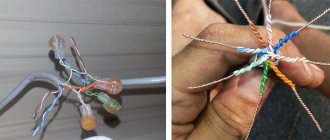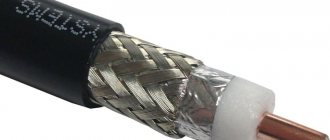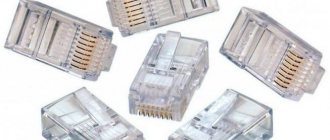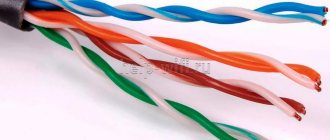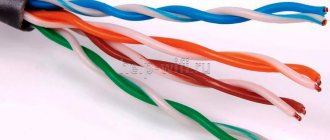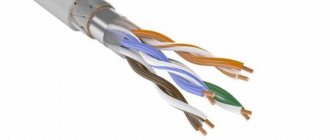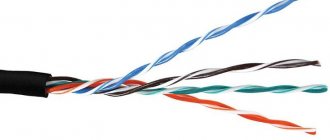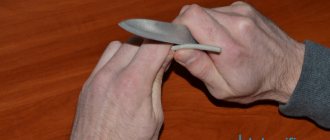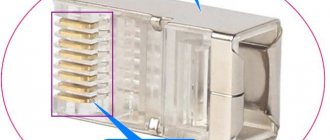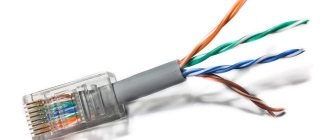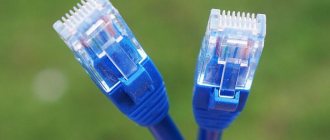Despite the introduction of wi-fi into almost all areas of human life, wired technologies have not lost their relevance. In particular, we are talking about twisted pair cable. The key to success largely lies in stable work, regardless of conditions. For example, an ordinary user who connected a computer to a local network encountered it. No small importance is given to the quality of compression. It determines the speed of your network connection and whether errors will occur. If the need to carry out such manipulations arises at home, there are no specific requirements for the quality of the connection; they make do with the means at hand. Those who are employed in the IT industry and daily service up to 100 computers in the office and beyond should think about purchasing the appropriate tools. They will significantly speed up the process and improve the results obtained.
What is twisted pair?
A type of cable used to organize a local network consisting of several computers. The conductors are twisted in pairs. This is necessary to acquire protection from external influences; in addition, in this state they themselves do not act as a source of interference. The quality of communication improves, since the electromagnetic waves generated in the pair have a uniform effect on the wire and lead to a reduction in mutual interference during signal transmission.
The power cord can have 2 or 4 internal cores. Different voltages in the conductors of one element provide an information signal.
The conductors that form the element are made of copper. Polyvinyl chloride or polypropylene is used as insulation. For the premium class, Teflon and polyethylene are appropriate. They are characterized by low dielectric losses and reliable protection against overheating.
The use of nylon thread for tearing greatly simplifies the cutting process. The outer shell is made from polyvinyl chloride and fire-resistant polymers.
The PVC shell is covered with hydrophobic polyethylene. The empty area is filled with the same gel. Sometimes they add a reservation with a special tape.
The shells received different colors:
- black (protection from dampness);
- orange (flame resistant);
- light gray (designed for installation inside residential buildings and offices).
Copper cable has a number of undeniable advantages that allow it to compete with optical networks and wireless technology.
Advantages:
- clean signal without interference (especially for grounded wires with a screen);
- the line supports the transmission of audio, video, telemetric data;
- low installation cost.
Flaws:
- reduction in signal quality at a distance of more than 2 km;
- limited number of twisted pairs in the cable.
Crimping a twisted pair cable is a connection to a connector. The last one is a special eight-pin 8P8C connector. It is worth noting the fact that the unofficial name RJ45 was assigned to it. This is one of the most popular misconceptions. Crimping is carried out according to certain standards, without confusing colors.
The quality of signal transmission depends on how effectively it is carried out.
How is it carried out?
The procedure boils down to placing the wires into the grooves of the connector. Inside there is a special plate with slots - knives. They are necessary for cutting the protective shell and for additional pressure. The contact obtained in this way is not inferior in reliability to soldering.
RJ45 twisted pair installation includes:
- pruning;
- shell removal;
- cutting wires;
- connector crimping.
Securing the connector to the patch cord during crimping requires maximum concentration and attention from the performer. The slightest mistake can lead to breakdown of a single node or the entire communication system. It is preferable to purchase highly specialized tools, as they improve the quality of work and minimize errors.
Materials and tools for work
There are three components involved in creating a connector connection:
- Internet cable – twisted pair;
- connector;
- crimping Tools.
Internet cable - twisted pair
Twisted Pair Crimping Tool: Crimping Tool
Wired products consist of four pairs of insulated wires, twisted together, enclosed in a PVC sheath. Twisting of wires is necessary to increase the connection between them and reduce the influence of external electromagnetic fields.
8-core twisted pair cables are used in computer communication lines to transmit information signals. The twisted pair cable is connected to PC devices using 8P8C connectors, which are also called RJ 45.
In addition to the eight cores, the sheath contains a polymer thread that keeps the conductors from spreading under the outer sheath. In preparation for crimping the ends of a twisted pair cable, the PVC cord is cut off.
Connector and its device
The connector is a transparent or colored plastic box with two openings at the ends. One of them is equipped with 8 blade contacts. The prepared ends of the wires are inserted into the second passage. Blade contacts are made in such a way that when the wires are pressed into the contactor, the blades cut off some of the insulation from them.
Twisted Pair Crimping Tool
Unlike ordinary pliers, the RJ 45 crimping tool is equipped with seats that, when closed, form an opening slightly smaller in size than the cross-section of the connector. Due to this, the crimping device compresses the connector body so gently that it does not cause damage.
Important! It is convenient to use a crimper with a knife to trim the top sheath of a twisted pair cable. This eliminates the risk of unnecessary cutting of the PVC layer, which can lead to disruption of the integrity of the cores.
Crimper
Crimping is impossible without special pliers designed for working with telephone and network communications. For open electrical systems, this technique is the preferred option compared to soldering and welding.
Crimper required:
- for removing insulation;
- removal of damaged areas;
- installation of RJ-45 and RJ-11 connector (telephones).
Externally, the tool resembles pliers. The difference lies in the design of the jaws, which are mainly connected by a hinge mechanism. On the inside there are special recesses for a certain size of connectors and bushings - matrices. The jaws are closed through a hinge or parallel to each other. The working part is made of painted steel, less often improved. The edges are hardened and treated with an anti-corrosion compound. The head part has a curved or round shape. This reduces stress on the wrist. To increase productivity and comfort of use, the handles received a plastic coating, often with rubberized inserts. The length depends on the purpose. It varies from 175 to 210 mm.
How are they labeled?
A crimper is a universal device used for crimping cables. There are models on the market that are compatible with several types of wires. This became possible due to the fact that several different sockets were carved into the jaws. The number ranges from 4 to 6.
For identification, special markings are used. It is applied next to the matrix socket. In most cases, crimpers are universal, but there are also highly specialized models on the market.
- 6P (telephone cable);
- 8P (8P8S).
Often sleeve and tip manufacturers produce proprietary equipment. It is color coded. Matching with matrix socket makes it easy to use. There are no general standards for such classification. Interaction with cases of a certain brand and color can lead to a negative result when using a crimper from another manufacturer, despite the same color. Before use, you must pay attention to the letter designations, or use everything from one manufacturer.
What are they?
- Scissor. Reminds me of ticks. They are comfortable to work with, compress easily, are compatible with almost all tips, but work best with wires of small cross-section. Mainly used in organizing household networks. Often equipped with removable matrices. A set with replaceable templates is attached to the jaws. The solution allows you to use the tool in all possible cases.
- Retractable. Massive and heavy group. The parallel movement of the jaws allows for uniform compression. This connection is characterized by high reliability. The only drawback is that the operation takes longer.
- Collet. Universal group. The matrix was replaced with a diaphragm, which is compressed from 4 or 6 sides. The wire, regardless of diameter, is placed in the device and is evenly compressed on all sides. Before purchasing, please note that the crimper is not compatible with a number of popular tips. Pliers cannot be used when extending long wires. This is due to the closed head; after manipulation, it cannot be removed from the wires and embedded in communications.
Crimpers can be divided into 2 large groups:
- Automatic. Consists of an electric drive and an applicator compatible with a specific handpiece. With its help, wires are cleared of insulation, connectors are installed, floors are crimped using an automatic method. The group is designed for fast and efficient work with thick cables.
- Manual. The most popular and widespread group. They are divided into types depending on the tip (universal, specialized, hydraulic and electric).
How to work as a crimper?
The use is quite simple and does not cause any difficulties. It is enough to adhere to a certain sequence.
- Carefully remove the insulation according to the size of the tip. The wires are separated and cut off. They should be the same.
- The prepared cores are placed in the grooves according to the established sequence. For a tight crimp, install into the connector until it stops.
- The device is mounted into a connector in the fixture. Cut through the insulation. Make sure to make contact with the cord.
- By pulling the connector and wire in different directions, check the quality of the fastening.
- To test performance, special equipment is used. Green LEDs indicate a positive result, red LEDs indicate twisted wires or a short circuit. If there is no indication, a break has occurred.
How to choose?
Those who are involved in building telecommunications networks pay special attention to the selection of tools. It is possible to avoid problems at the wrong time, as well as fatigue during prolonged use, if it meets a number of criteria.
- Weight. Excessive lightness indicates low strength. Purchasing a crimper that is too heavy will cause the performer to get tired quickly. The heaviness should be felt, but in moderation.
- Ergonomics. The gun fits comfortably in the hand. Preferable with handles that have an anti-slip coating with grooves for fingers. The plastic is securely fastened and does not rotate. Discomfort caused by fatigue and chafing of the hands will reduce the effectiveness of completing tasks.
- Symmetry. The handle and press are placed on a common axis; curvature is unacceptable. There should be no displacements.
- Make sure there are no backlashes or jamming. Such problems indicate displacement of the driving knives relative to the grooves of the connector. The quality of crimping is significantly reduced, and the information signal may be lost.
- Functionality. Multi-position clamps with 2 - 3 RJ-11 or RJ-12, RJ45 sockets are preferred. Most models have stripping blades. This allows you to avoid purchasing special tools. The disadvantage is the increased weight. Having a special knife for even cutting will not be superfluous.
- Is there a ratchet? The option blocks the reverse movement of the handle and reduces hand fatigue.
- How the connector is installed when crimping. There are vertical and horizontal models. The choice depends on the performer.
Crimping Tools
To create a fully functional patch cord, you will need a standard network cable, as well as two or more RJ-45 connectors. The installation tool kit includes:
- Press pliers (crimpers).
- Stripper is a device for removing insulation.
- Knife.
- Screwdriver.
- Wire cutters, pliers.
On the right is a cheap, inconvenient one, and on the left is a good, expensive crimper
Also, for crimping, prepare several adapters and plastic protection in case the cable breaks.
Stripper
It is used to remove insulation to gain access to individual wires. In premium models, the length of the stripped area is adjustable. Some of them support the functionality of a universal crimper. Strippers are available equipped with an additional knife or nippers for even cutting. The modification is relevant if the crimper has not received similar functionality. Most users prefer to perform such actions using a utility knife. For those who care about the speed and quality of the work done, you should think about mastering a stripper, since only with it can you achieve high-quality and quick removal of the outer shell.
Working with it does not cause much difficulty; it is enough to place the required piece in a special hole and press it down, turning it around the axis, and remove the cut insulation by hand. During manipulations, bending the conductor is strictly prohibited.
Advice from experienced users will help increase the efficiency of the operation, as well as avoid defects:
- Damage to the shell should be avoided, as in the future it will become a source of interference and other types of network problems;
- when removing the top layer of insulation, leave a small margin so that it fits inside the plastic tip and is fixed, this minimizes the risk of breaking individual wires at the base of the connector;
- stripping the end of the cores is not necessary; with sufficient force on the handle, the contacts will break through the insulation on their own.
The stripper is not compatible with foil-coated FTP twisted pair cable. They work with it using nail scissors.
The stripper comes in a wide variety of shapes. The part is represented by pliers, with straight jaws, or a curved working part and an end grip. This design makes it easier to work in confined spaces.
The stripper can have a cylindrical shape, with holes with blades located on the side.
Marking
The stripper is compatible with a cable of a certain cross-section. The value varies from 0.2 - 0.5 to 6 - 10 mm2. The blade is equipped with several holes, opposite which the cross-section is indicated. The numbers are in square millimeters and AWG, representing the gauge.
The handles are covered with insulating material that can withstand voltages up to 1000 V. Strippers with the function of crimping terminals of a specific color. They match the ferrule cuffs.
- Red (0.25 – 1.5 mm2).
- Blue (1.0 – 2.5 mm2).
- Yellow (2.5 – 6.0 mm2).
How to choose?
- Make sure there are no backlashes or creaks.
- Study how the blades are installed. If they are located too close to the handle, it is better to refuse the purchase. This is due to the high probability of damaging your finger.
- Supports cutting depth adjustment. The function is relevant for people working with wires of different thicknesses.
Advantages and principle of crimping
When organizing a local computer network, home or small office, the user inevitably faces the problem of crimping the end connectors on a twisted pair cable. In some cases, you can buy a ready-made cable with connectors, but it is not always possible to choose a patch cord of the required length. In addition, it is often necessary to crimp the cable only after it has been laid. You have to resort to the services of third-party specialists and pay them for this work.
In fact, anyone, even a novice network administrator, can crimp a twisted pair cable on their own. All you need for this:
- Internet cable crimping tool;
- a little training in performing such work.
First of all, you need to decide how and why the connection will be made.
Note! When connecting a computer to a router, a so-called direct link is used.
In this case, the colors of the twisted pair wires on both sides alternate in the following order:
- orange - white;
- orange;
- green - white;
- blue;
- blue White;
- green;
- brown - white;
- brown.
Computers are connected to each other using a cross-link. In this case, on one side of the line the wires alternate, as indicated above, and on the other, you should do this:
- green - white;
- green;
- orange - white;
- blue;
- blue White;
- orange;
- brown - white;
- brown.
Important! The standard twisted pair connector is RJ-45. If you have no experience installing connectors on a cable, it is better to buy them with a reserve, since in case of failure, you will not be able to reuse the connector.
Cable tester
After completing the crimping work, you need to make sure that the constructed network is working properly. For this purpose, professionals use a special electronic device with an RJ-45 connector.
A cable tester allows you to identify a number of important characteristics:
- length;
- wiring diagram;
- the amount of signal attenuation;
- level of interference at the near edge;
- copper loop resistance;
- loss on return.
A simple tester consists of two parts: main (master), remote (remote). One of the edges of the cable is connected to them. The modules are equipped with 1 to 8 indicator lights, the number corresponding to the number of conductor plus ground G. In normal condition they flash green. If there is a malfunction, there is no light. The red indication indicates that the wires are mixed up or a short circuit has occurred. Some models are equipped with a sound alert.
Using the tester, the following is detected:
- location of the break, a specific conductor;
- Is the wiring done correctly?
- presence of a short circuit.
Electronic devices are divided into:
- Protozoa. They have a light indication and help identify problems on the line such as mechanical damage and correct connection.
- With extended functionality. Built-in tone generators help identify split conductors.
- With LCD display. A tool with wide functionality. It allows you to identify all errors, as well as the distance to a break or short circuit, the type of outlet and the length of the wire.
Step-by-step algorithm for checking the functionality of twisted pair cables
- Make sure the cable is ready for use.
- One edge of the wire is placed in the main one, the other in the remote one.
- Turn on the device.
- If the signal passes successfully, the indicators turn green.
- The absence of light indicates a malfunction. To eliminate them, you may even need to replace a section of the cable.
How to choose?
A thoughtless purchase may result in the device being useless in certain situations. It is possible to avoid such problems if you pay attention to the following:
- the basic set of functions includes diagnostics of breaks and short circuits, the ability to determine shielding is preferable;
- the minimum length of the tested section is 300 m;
- for diagnosing installed networks, a length detector with a tone signal is important;
- support for twisted pairs categories 5, 5e, 6;
- The LCD display will make it easier to read the test results.
Schemes for crimping twisted pair cables
Ferrule crimper
There are three options for crimping connectors:
- Direct connection Straight;
- Cross connection Cross Over;
- Crimping a four-core cable.
Straight Direct Connection
Direct crimping is used to connect a PC network card to various compatible equipment: switch, hub and router.
The “PC – router” scheme is that the order of the conductors in the connectors is formed in a mirror image. If in the original connector the green-white wire is located on the right, then on the output connector it occupies the extreme left position. The rest of the conductors also change their order of priority.
This crimping is performed according to two standards: EIA/TIA-568A and EIA/TIA-568B.
Direct crimping order
Cross Over Connection
This type of twisted pair connection is used to connect two network cards directly. The arrangement of the conductors in the two connectors is distinguished by the reversal of the positions of the pairs of wires with each other.
The Cross Over scheme is used when connecting PC - PC, switch - switch, hub - hub, router - router. The contacts on the input and output connectors are swapped crosswise. This can be seen in the figure by the position of contacts No. 1 and No. 8.
Cross crimp
Crimping a four-core cable
If you plan to install a connector for a four-core cable, then 4 conductors are separated from the twisted pair. They are crimped in the same way as 8 twisted pair wires. The lower figure shows pinout options for 4 twisted pair wires.
Pinout Patch Cord, 4 wires
Crossing tool
A simple tool used to terminate twisted pair cables. It is necessary for connecting cables to cross-connections, plinths, panels and sockets. Power sockets clear the room of cables in wall and ceiling panels. Its use is relevant when laying a network.
A simple tool is a handle with a blade of a characteristic shape. Premium models received a hook for removing wires from their places and a screwdriver to make removing the plinths easier. Sometimes they come with a replaceable blade. A simple model is suitable for the home craftsman; for professional purposes, a “Swiss knife” is used.
For those who often have to deal with such work, it is preferable to pay attention to multifunctional models. It should include:
- customizable scissors;
- core position sensor;
- blade blocker;
- hook for removing from nests;
- screwdriver.
Additional functionality in the closed position is ergonomically hidden in the handle, like a Swiss knife.
How to work?
The procedure has much in common with twisted pair cable crimping.
- Remove the cover from the socket to provide access to the connection point.
- Remove the outer insulation at a distance of 6 - 8 cm.
- They unravel the cable.
- The veins are placed according to the color scheme. There are no tensions. The edges are trimmed with a blade.
- The working part is pressed into the socket to fix the cable.
- Close the lid and replace the socket or plinth.
Crimping tools and methods
In addition to a professional crimper or crimper, when attaching a connector, you can use pliers, pliers, and pliers. These are less effective crimping tools, but if you don't have a crimper on hand, these will do. Few people want to buy a professional tool for one-time use, and it costs a lot.
Special crimper
Before starting crimping, you should choose the type of future crimping, which can be:
- direct, which is used to connect the device’s network ports to a router or switch;
- crossover, which is used to directly connect several personal computers via network ports.
Direct view involves providing an Internet connection for routers, computers, TVs and set-top boxes. Divided into two standards:
- Standard 568A;
Connection 568A
- Standard 568V.
Connection 568B
Most often, it is the second standard that is used and the order of wire distribution in it is as follows: white-orange wire, orange, white-green, blue, white-blue, green, white-brown, brown.
Cross view is used when you need to connect two devices of the same type: computer - computer for a LAN network, switch - switch, and so on. With the development of technology, this type of connection has lost its uniqueness, as interfaces have appeared that make it possible to configure signal reception and transmit it automatically.
Cross connection type
It is also necessary to pay attention to the connection diagrams. The RJ45 plug of the 5e standard can be used in several variations: 4 pairs (8 wires), which allows you to achieve speeds of up to 1000 Mb/s and 2 pairs (4 wires), which provides a maximum of 100 Mb/s.
Important! The use of two-pair crimping at modern Internet speeds and tariffs is simply meaningless, so its crimping will not be considered.
Having dealt with all the nuances, you can move on to the process of crimping the wire using various tools.
8P8C connectors
Crimper
If you have a special 8P8C plug based on RJ45, the step-by-step instructions are as follows:
1. Prepare a cable of the required length, taking into account all options for its laying and an allowance of one decimeter for removing the insulating layer;
2. Use a puller to remove the outer insulation of the wire and release four pairs of wires;
3. Leave about two centimeters of the wire uninsulated and unwind the twisted pair;
Working with the crimper is easy and simple
4. Cut off excess bare wires so that they are only in the connector;
You might be interested in this M416 grounding meter
5. Insert the wires into the connector in accordance with the selected diagram;
6. Insert the connector into the RJ45 port of the crimper and slowly but firmly squeeze the handles until a characteristic sound is heard, which will be a signal of success;
7. Crimp the second side and check the functionality of the cable.
Special stripping tool
The best crimpers for crimping twisted pair cables
Cablexpert T-210 orange
Crimping pliers will become a reliable and faithful assistant for system administrators and home craftsmen. Compatible with RJ-45 connector. The working part is made of steel. To increase comfort during operation, the handle is covered with plastic. A significant advantage will be the ability to clean the conductor from insulation and subsequently trim it. The knives will not be difficult to replace. Compact dimensions and low weight will be an additional advantage.
Cablexpert T-210 orange
Advantages:
- nice price;
- simple design;
- do not require additional skills and abilities;
- for home use.
Flaws:
- the quality of the plastic raises questions;
- specific grip;
- no anti-slip coating;
- The cable cut length limiter interferes with the efficient performance of tasks.
Gross 17719
Taiwanese telephone and computer wire crimping pliers are compatible with the main sizes involved. The blades are made of SK5 tool steel. The two-component handle is pleasant to the touch and fits comfortably in the hand. Thanks to the ratchet mechanism, the contact is not interrupted until the end of the operation.
Gross 17719
Advantages:
- tool steel;
- two-component plastic handle with rubberized inserts;
- convenient placement of the connector eliminates the need to twist the cable, as with many other models;
- for professional activities;
- The spread of the handles is designed for small hands.
Flaws:
- the ratchet mechanism periodically fails;
- low quality blade for cleaning the conductor;
- the nuts need to be tightened periodically;
- During the cutting of the veins, 1 - 2 pieces are possible.
Knipex KN-975112
Professional product for interaction with twisted pair cables. Forged chrome vanadium steel with additional oil hardening guarantees premium quality. This product can withstand heavy loads and will last a long time. The design provides a longitudinal cutter and a knife for processing an area up to 12 mm long. Efficient force transmission via the linkage reduces fatigue. The crimper is equipped with a matrix with 3 slots. It supports precise parallel crimping. To improve quality, we equipped it with a forced locking function.
Knipex KN-975112
Advantages:
- compatible with 4, 6 and 8 way Western format plugs;
- support for working with round cables;
- two-component handles with anti-slip safe coating;
- blued steel handles;
- Made in Germany.
Flaws:
- too expensive;
- The delivery kit does not include a screwdriver for servicing the crimper.
Hand-held companion tool
Such devices include RJ 45 testers (LAN testers) and cable strippers.
LAN tester
The RJ45 network tester is designed for diagnosing cable networks connecting PCs and computer equipment. The twisted pair tester has two USB inputs. Check the condition of the cable as follows:
- connectors of both ends of the cable are inserted into the openings of the device;
- the LED chains of the two tracks begin to light up, checking all the cores of the twisted pair;
- if the windows blink synchronously, this means the cable is in good condition;
- otherwise, a failure in the order of the rhythmic burning of the indicators indicates that a break has occurred in some veins.
Additional Information. For long lengths of twisted pair cables, two parts of the tester are used. They are placed at the ends of the wire and connectors are connected. The head of the device will display reliable information about the state of the entire twisted pair.
LAN tester
Cable strippers
These are fairly simple devices for removing the sheath from the end of a twisted pair cable. As a rule, this is a split cylinder with a sickle-shaped blade inside. The device covers the cable and makes a circular motion. As a result, the required section of the sheath is cut off without damaging the insulation of the twisted conductors.
The best strippers for crimping twisted pair cables
Hyperline HT-352A
A universal device used to work with twisted pair cables. The body is made of ABS plastic reinforced with fiberglass and can withstand medium mechanical loads. A stainless steel knife cuts through almost any material.
Hyperline HT-352A
Advantages:
- notch adjustment;
- replaceable cartridge with knives for different types of conductors;
- universal device;
- made in Taiwan.
Flaws:
- there is no cutting knife;
- only 1 nest;
- often disappears from shelves.
Knipex KN-169501SB
The new product takes the stripping operation to a fundamentally new level of comfort. The stripper has an innovative ergonomic design. The edges are formed into a cone for a reason. This makes it much easier to access wires in narrow spaces. Guide edges make installation easier for stripping.
Knipex KN-169501SB
Advantages:
- body made of glass fiber reinforced plastic;
- does not slip in the hand;
- German quality.
Flaws:
- for use with the right hand only;
- performs poorly when interacting with a flat cable;
- longitudinal cut in the middle of the handle.
Panduit CJAST
Products from a world-famous company. It occupies a leading position in the field of innovative developments and infrastructure solutions. They solve issues related to interaction with life support systems of buildings. The company's portfolio includes all the necessary equipment for building data centers, cable systems and the industrial Internet.
Panduit CJAST
Advantages:
- compact dimensions;
- plastic case;
- work is carried out with one hand;
- American brand.
Flaws:
- high price;
- not compatible with flat cables.
Instead of an epilogue
It is preferable to select a tool for working with twisted pair depending on the set of actions that will need to be performed. At the same time, you should pay attention to which wires, terminals and modular connectors will need to be processed. Typically, for standard network pulling and installation, tools for installing the connector and checking the quality of the connection are suitable. When large-scale work is expected, and especially outdoors, then a combined device will be the best choice.
As for the fullness of the market for the devices under consideration, in the segment of precision measuring instruments the undoubted leaders are representatives of domestic companies. This situation became possible because they created conditions for easier state registration. At the same time, the segment of crimping devices is more focused on Western models, and it is difficult to identify a clear leader. However, representatives of Asian companies turned out to be cheaper and less reliable. In the segment of devices for laying twisted pair cables, models from the Eastern European manufacturer are in clear demand, despite their rather considerable cost. Of course, the rather high price is compensated by the presence of many additional accessories and workmanship.
Best Cable Testers for Twisted Pair Crimping
PROconnect 468
The model has undergone significant changes compared to its predecessor. The first thing that catches your eye is the bright yellow body, made of impact-resistant plastic. The circuitry has been updated. Quality casting combined with reliable components improves accuracy and efficiency.
The device includes 2 functional blocks, a transmitter and a receiver. LEDs are installed on both parts. When connected, they form a single, unbreakable circuit.
PROconnect 468
Advantages:
- performance;
- stylish design;
- effective implementation of assigned tasks;
- light weight;
- affordable price.
Flaws:
- Crowns are not included in delivery;
- cannot be repaired if broken.
Noyafa NF-488
Necessary for studying the state of a new or existing network, constructing pinouts, measuring voltage, current and power. The emitter body is equipped with 2 RJ-45 ports to determine the characteristics of PoE power supplied by network devices.
Noyafa NF-488
Advantages:
- checking the power consumed by connected devices;
- studying the state of the local network;
- defining a loop-back ring on the switch;
- checking the functionality of the network port response.
Flaws:
- food from crowns;
- impossibility of determining the length of a twisted pair.
FLUKE PRO3000
The test set is used to identify problems that could arise during the installation of a local network. A louder speaker helps speed up ray tracing in drywall, wood and other materials.
Operation is supported by the unique patented SmartTone technology. It consists of sending 5 distinct tones to identify individual pairs.
The tester consists of a tone generator and an inductive antenna probe.
FLUKE PRO3000
Advantages:
- unique patented technology;
- effectively copes with the task;
- manual adjustment of probe sensitivity;
- not fixed power button exception random operation in the case.
Flaws:
- high price.
Best cross-connect tools for crimping twisted pair cables
REXANT 110 (ht-3140)
The new product is indispensable when laying cables on cross-connects, patch panels, sockets and modules; it is compatible with type 110 contacts. The double-sided tool steel blade effectively cuts conductors of any thickness. It is possible to replace the working part. The storage compartment for replaceable blades in the handle will please everyone. The plastic handle with a ribbed surface does not slip in the hand.
REXANT 110 (ht-3140)
Advantages:
- spring-loaded support for attaching the blade;
- The delivery set includes a knife with a double-sided cut;
- bright design;
- made of tool steel.
Flaws:
- It is difficult to purchase a separate blade for replacement.
Cabeus HT-3640R
This universal compact product is equipped with replaceable blades and inserts for cross panels of any type. The material used for the body was ABS plastic reinforced with glass fiber. For convenience, the handle is covered with thermoplastic rubber. Sharp chrome molybdenum steel blade edge.
Cabeus HT-3640R
Advantages:
- Twist-Lock for fixing and quickly changing knives;
- The handle has a blade holder.
Flaws:
- blade is not included in delivery.

